Checks with 2-D codes now in use in Turkey
Diyadin Yakut*
 As it is widely known, a check is a document that carries an official order for a specific bank to pay a certain amount of money from the issuer’s (drawer) bank account to the person holding the check or the person in whose name the check has been originally issued.
As it is widely known, a check is a document that carries an official order for a specific bank to pay a certain amount of money from the issuer’s (drawer) bank account to the person holding the check or the person in whose name the check has been originally issued. Historically, checks as a mean of payment have been extensively employed by virtually all agents of the economy to enable economic transactions (some of them reaching huge quantities) without the need to carry large amounts of money.
Although primitive forms of checks as a sort of non-monetary payment for economic transactions can be traced back to as early as ancient times, widespread exploitation of checks as a primary method for cash transfer, both in Turkey and across the world alike, could only take place in the second half of the 20th century.
After technological advances paved the way for automatic “check generation and processing,” the volume of issued and circulated checks through market channels to facilitate economic transactions peaked by the mid-1990s, with billions of checks used annually.
Since then, the number of checks issued and employed as a means of payment has been on a downward trend due to some principal developments, including the emergence of electronic payment systems as the dominant method the vast majority of individuals and entities prefer to employ. The position of Turkey, in terms of the annual volume of checks, is not an exception to this spreading global trend.
Despite sharp drops in the volume of checks used at an accelerating pace both at home and abroad, a significant proportion of economic transactions are still being carried out via checks. According to recent figures revealed by the Union of Chambers and Commodity Exchanges of Turkey (TOBB), the overwhelming majority of the commerce with post-dated payment conducted by corporate entities is still being carried out via approximately two million checks. The fact that the volume of commerce with post-dated payment, which amounts to 2.4 trillion Turkish Liras, is 65 percent of the total economic transactions blatantly manifests the vital significance of checks for the soundness of the general economy and smoothness of everyday commercial life.
Drawing on the mounting sense of urgency to solve the problems of fake, stolen and dud checks, particularly after the abolishment of imprisonment for “dud check drawers” with a legal amendment in February 2012, the government sat out to devise a new check-writing system called “checks with 2-D Codes,” or checks that carry data matrixes on their surface to stem or at least significantly diminish distortions in commercial life caused by widespread usage of these fake, stolen and dud checks. The new system went into effect on June 15, 2015.
How does the system function?
Triumphed by government officials as the first of its kind both in Turkey and abroad, checks with 2-D codes are expected to solve the “fake, stolen and dud checks problem” faced by many private sector agents on a daily basis due its special feature which enables check-holders instant control by comparing the data recorded on the matrix implemented into the surface of the check and data stored by the Bureau of Credit Registration, a semi-governmental body established with the objective of facilitating the exchange of information and documents between credit institutions and financial organizations.
Considering that check-holders are easily able to acquire the past payment performance of the check-drawers simply by scanning the 2-D codes with the help of special program downloaded onto their smart phones, we can safely assume that even the circulation of dud checks, let alone the circulation of fake and stolen ones, will come to an complete halt.
Just like conventional checks, coded checks can be obtained from banks. Bank customers are free in choosing either coded checks or normal ones. Check-drawers can use both type of checks at the same time.
In case of demanding coded checks from banks, the drawers are obliged to share some data with check printing banks regarding their retrospective payment performance to the extent these revelations do not fall into the context of the “violation of commercial secrets.” The same drawers should accept that this data will be available to prospective check-holders by the banks once these checks are written to finance their commercial transactions.
Content of data available to check-holders
As pointed out above, not all of the commercial data of check-drawers is provided to prospective check-holders due to collective sensitivity over safeguarding the commercial secrets of relevant check issuers. The following information regarding the drawers of the checks is included in the “Check Report” that appears on the screen of smart phones which scan the 2-D code with the help of the special program called Findeks
Mobil:
The name, surname and bank account of the drawer,
The check-printing bank, its relevant branch and the number of the specific check,
The dates of the first and last check submitted to a bank by previous holders,
The number, amount and percentage of checks paid by banks upon submission of these checks by their previous holders,
The number, amount and percentage of endorsed, paid with a delay or still not paid checks.
The information lined up above can be obtained by the check-holders in the form of one, three or 12-month reports to make sure those who have given them checks in exchange for cash payment have a reliable payment performance in their previous transactions.
*Diyadin Yakut is a tax inspector at Turkey’s Finance Ministry
















